

 Br Pd(0)
Br Pd(0)
IV.2.2 Intramolecular Heck Reaction
IV.2.2.1 Synthesis of Carbocycles
STEFAN BRÄSE and ARMIN DE MEIJERE
A. INTRODUCTION
The possibility of constructing carbocycles by intramolecular Heck reaction makes it particularly versatile for organic synthesis.[1],[2] The starting materials, alkene-tethered haloalkenes and haloarenes, are in general readily available from simple precursors, and thus this strategy has been used for the preparation of various types of carbocyclic systems. In this section, the cyclization of haloalkadienes to give carbomonocyclic structures is described. While the carboannelation of heterocycles is included here, the domino and cascade reactions involving two or more intramolecular Heck coupling steps are covered in Sect. IV.3.
B. CYCLIZATION OF 2-HALO-1,(n 1)-ALKADIENES
AND RELATED COMPOUNDS
B.i. General Remarks
By Pd-catalyzed intramolecular coupling of 2-halo-1,(n 1)-alkadienes and related compounds, all ring sizes from threeto nine-membered are attainable, either by exo – trig for threeto nineor endo – trig cyclizations for sixto nine-membered rings (Table 1).[1] Applications toward the construction of larger rings (sizes 13 – 24) have been demonstrated for substrates on solid support in combinatorial syntheses (see also Sect.X.3),[3] by employing slow addition of the substrate and/or high dilution techniques.[4]
B.ii. Synthesis of Cyclopropanes
The synthesis of cyclopropanes by simple cyclization of 2-halo-1,4-pentadienes has not been achieved, presumably because the product 1,2-dimethylenecyclopropane would not be stable under the reaction conditions necessary for ring closure. However, the formation of bicyclo[n.1.0]alkanes from certain 2-halo-1,3-pentadienes (Sect. IV.2.2.1.C.iii.a) or by a cascade reaction (Sect. IV.3.1) has been achieved.
Handbook of Organopalladium Chemistry for Organic Synthesis, Edited by Ei-ichi Negishi ISBN 0-471-31506-0 © 2002 John Wiley & Sons, Inc.
1223
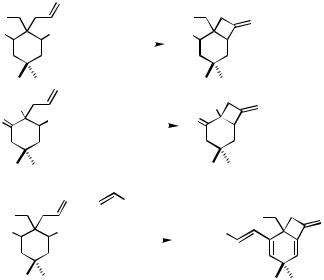
1224 |
IV Pd-CATALYZED REACTIONS INVOLVING CARBOPALLADATION |
|
TABLE 1. Examples of Ring Sizes Achieved by Intramolecular Heck Reactions |
||
|
|
|
Ring Size |
Reference for endo-trig(dig) |
Reference for exo-trig(dig) |
|
|
|
3 |
|
[5]–[7]a |
4 |
|
[8],[10] |
5 |
|
[4],[12]–[35] |
6 |
[14],[36]–[38],[80] |
[13],[16],[23],[27],[38],[39]–[53] |
7 |
[38],[54]–[57],[80] |
[16],[58]–[62] |
8 |
[42],[54,[55],[59],[63] |
[60],[61],[64],[65] |
9 |
[54],[55] |
[66]b |
10 – 15 |
[4],[66] (13) |
[66] (11,12)b, [67] (12 – 15)c |
16 – 19 |
[68] (16), [69] (16, 18) |
[66] (18)b, [67] (16, 17)c |
19 |
[66] (21), [69] (20, 22), [3] (20 – 24), [4] (26) |
|
|
|
|
aThe formation of three-membered rings is reversible: Compare Ref. [38c]. bWith allene coupling partners instead of alkenes.
cHeck – Stille cascade.
B.iii Synthesis of Cyclobutanes: Cyclization of 2-Halo-1,4-hexadienes
and Related Compounds
The cyclization of simple 2-halo-1,5-hexadienes to yield 1,2-dimethylenecyclobutanes has not been achieved so far.[34] Presumably, a rapid Cope rearrangement of the starting 1,5-hexadiene may inhibit such a process or ring-opening polymerization of the initially formed 1,2-dimethylenecyclobutane derivative may prevent its isolation. However, when the functionalized double bond is incorporated in a six-membered ring, cyclization with a tethered alkenyl group to give an 8-methylenebicyclo[4.2.0]oct-1-ene derivative does occurs. Starting from dimedone, novel cyclohexa-1,4-diene-1,5-diyl bis(nonafluorobutanesulfonates) have been prepared and cyclized under palladium catalysis to cleanly give bicyclo[4.2.0]octadienes and bicyclo[4.2.0]octenones, respectively, by unprecedented 4-exo-trig processes (Scheme 1). In the presence of a chiral
Ph |
|
|
|
|
Pd(OAc)2, PPh3 |
Ph |
||||||||
NfO |
|
|
|
ONf |
Et3N, DMF |
H |
||||||||
|
|
|
|
|
|
|
|
80 °C, 12 h |
|
|
|
|
|
|
|
|
|
|
|
|
|
|
|
|
|||||
|
|
|
|
|
|
56% |
|
|
|
|
|
|
||
R |
|
|
|
|
|
|
Pd(OAc)2, PPh3 |
|
R |
|||||
O |
|
|
|
ONf |
|
|
Et3N, DMF |
O |
||||||
|
|
|
|
|
|
|
|
80 °C, 12 h |
|
|
|
|
||
|
|
|
|
|
|
|
|
52–65% |
|
|
|
|
||
|
|
R = Bn, allyl |
|
|
|
|
|
|
|
|
|
|||
|
|
|
|
|
|
|
|
CO2t-Bu |
|
|
|
|
||
Ph |
|
|
|
|
|
Pd(OAc)2, PPh3 |
|
|
|
Ph |
||||
NfO |
|
|
|
ONf |
|
Et3N, DMF |
t-BuO2C |
|||||||
|
|
|
|
|
|
|
|
80 °C, 12 h |
|
|
|
|
|
|
|
|
|
|
|
|
|
|
|
|
|||||
43%
Nf = C4F9SO2
Scheme 1

IV.2.2.1 SYNTHESIS OF CARBOCYCLES 1225
catalyst the BINAP ligand furnished the products with modest asymmetric induction (up 53% ee).[10]
B.iv. Synthesis of Cyclopentanes: Cyclization of 2-Halo-1,6-heptadienes
and Related Compounds
Intramolecular Heck reactions have frequently been used for the synthesis of cyclopentanoid structures. In nearly all cases reported so far, the ring closure occurs as a 5-exo process (for an exception, see Table 4, entry 6), for which 2-halo-1,6-heptadienes and related compounds are the appropriate starting materials. In some cases, however, these substrates cyclize by a 6-endo mode to give cyclohexane derivatives (see Sect. IV.2.2.1.B.v).
Simple open-chain 2-bromoheptadienes have frequently been used as substrates to generate 1,2-dimethylenecyclopentanes (Tables 2 and 3), which in turn have served as valuable starting materials in Diels – Alder cycloadditions. It has turned out to be even more favorable to carry out the intramolecular Heck reaction and subsequent Diels–Alder reaction as a domino-type sequence in a single operation (see Table 6). In the presence of secondary amines, aminoalkylcyclopentanes are produced (Sect. IV.3.2).
Cycloalkenyl groups as acceptors in the carbopalladation step have frequently been employed to form bicyclic systems (Table 3, entries 2, 5, 6; Table 4, entries 2, 3, 5, 12). These developments have contributed toward applications in the total synthesis of natural products as, for example, aphidicolin (Table 3, entry 5; see also Table 9, entry 9). [17],[18] In some cases, the formation of 6-endo products (Scheme 2) and/or double bond isomers can be prevented by using 2,6-dihaloheptadienes rather than the monohalodiene substrates (see Table 2, entry 8).[31]
X |
“Pd” |
+ |
|
|
5-exo 6-endo
Scheme 2
Especially under classical Heck conditions, that is, in the presence of PPh3, the coupling of an o-halostyrene formed in the first two coupling steps of an o-dihalobenzene derivative may yield alkylideneindane and alkylindene derivatives by 5-exo-trig cyclization of the intermediate o-alkenyl(phenylethyl)palladium (Scheme 3)
This side reaction played a dominant role in the attempted sixfold Heck coupling of hexabromobenzene with styrenes and led to mixtures of various isomers of the expected hexakisstyrylbenzene derivatives.[75] Sixfold Suzuki and Stille coupling reactions of hexabromobenzene, however, worked perfectly well, to give hexakisalkenylbenzene derivatives in high yields.
Five-membered ring closure has also been observed upon Pd-catalyzed coupling of o-halostyrene derivatives with alkenes.[19] Apparently, an intramolecular carbopalladation with 5-exo-trig ring closure can favorably compete with -hydride elimination in the intermediate -(o-ethenylphenyl)ethylpalladium halide. This reaction mode for the alostyrene is observed especially under Jeffery conditions when the alkene is ethylene, propene, or an
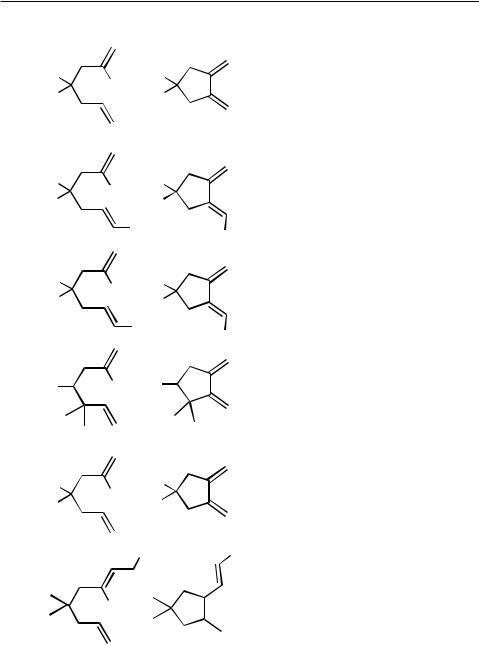
1226 |
IV Pd-CATALYZED REACTIONS INVOLVING CARBOPALLADATION |
TABLE 2. Synthesis of Cyclopentanes: Cyclization of Open-Chain 2-Halo-1,6-heptadienes and Related Compounds
|
|
|
|
|
Catalyst, Solvent, |
Yield |
|
Entry |
Starting Material |
Product |
Temperature |
(%) |
Reference |
||
|
|
|
|
|
|
|
|
|
|
|
|
|
Pd(OAc)2, PPh3, |
92 |
[34] |
|
E |
|
E |
K2CO3, MeCN, |
|||
1 |
Br |
80 C, 3.5 h |
|
|
|||
E |
E |
|
|
||||
|
|
|
|
|
|||
|
|
|
|
|
Pd(OAc)2, PPh3, |
90 |
[35] |
|
E = CO2Et |
|
|
|
MeCN, 80 C, 75 |
|
|
|
|
|
|
min |
|
|
|
|
|
|
|
|
|
|
|
|
|
|
|
|
Pd(OAc)2, PPh3, |
45 |
[70] |
2 |
E |
|
E |
MeCN, 80 C, 6 h |
|||
Br |
|
|
|||||
|
|
|
|
|
|
||
|
E |
E |
Pd(OAc)2, PPh3, |
|
|
||
|
|
|
|
||||
|
E = CO2Me |
Ph |
|
|
K2CO3, MeCN, |
88 |
[33] |
|
|
Ph |
30 C, 96 h |
|
|
||
|
|
|
|
|
|||
3 |
E |
Br |
E |
Pd(OAc)2, PPh3, |
45 |
[33] |
|
|
|
|
K2CO3, MeCN, |
||||
E |
E |
|
|
||||
|
|
30 C, 35 h |
|
|
|||
|
E = CO2Me |
E |
|
E |
|
|
|
|
|
|
|
|
|
||
4 |
|
|
E |
Pd(OAc)2, PPh3, |
74 |
[33] |
|
E |
Br |
K2CO3, MeCN, |
|||||
|
|
|
|
|
80 C, 12 h |
|
|
|
E = CO2Me |
|
|
|
|
|
|
|
R |
|
R |
Pd(OAc)2, PPh3, |
55 (19)a [32],[33] |
||
5 |
R |
Br |
R |
K2CO3, MeCN, |
|||
|
|
80 C, 2.3 h |
|
|
|||
|
R = MeCO |
|
|
|
|
|
|
|
|
R |
|
|
R |
|
|
6 |
|
I |
|
|
Pd(PPh3)4, Et3N, |
68 |
[26] |
|
|
|
|||||
|
|
|
MeCN/THF |
||||
|
|
|
|
|
|
|
|
R = OSiMe2(t-Bu)
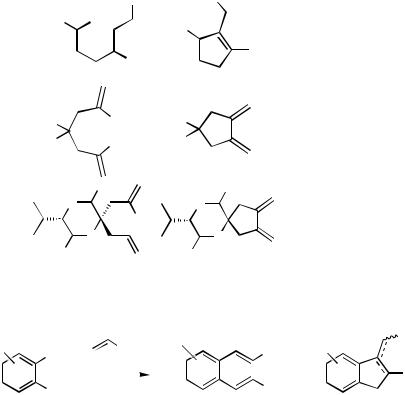
|
|
|
|
|
|
|
|
|
|
|
|
IV.2.2.1 |
SYNTHESIS OF CARBOCYCLES |
1227 |
|||
|
TABLE 2. (Continued) |
|
|
|
|
|
|
|
|
|
|||||||
|
|
|
|
|
|
|
|
|
|
|
|
|
|
|
|
|
|
|
|
|
|
|
|
|
|
|
|
|
|
|
Catalyst, Solvent, |
|
Yield |
Ref- |
|
|
Entry Starting Material |
Product |
Temperature |
|
|
(%) |
rence |
||||||||||
|
|
|
|
|
|
|
|
E |
|
E |
|
|
|
|
|
||
|
C4H9 |
|
|
|
|
|
I |
C4H9 |
Pd(PPh3)4, Et3N, |
|
|
|
|||||
7 |
|
|
|
|
|
|
|
|
63 |
[26] |
|||||||
|
|
|
|
|
|
|
|
|
|
|
|
||||||
|
|
|
|
|
|
|
|
E |
|
|
|
E |
MeCN, 100 C, 16 h |
|
|
||
|
|
|
|
|
|
|
|
|
|
|
|
|
|
|
|
|
|
|
E = CO2Me |
|
|
|
|
|
|
|
|
|
|||||||
|
H2N |
|
|
|
|
|
Br |
H2N |
Pd(PPh3)4, Ph2P-C6H4 |
|
|
||||||
|
|
|
|
|
|
polystyrene, K |
CO |
, |
68 |
[31] |
|||||||
8 |
|
|
|
|
|
|
|
|
|
|
|
2 |
3 |
|
|||
|
E |
|
|
|
|
|
Br |
E |
MeCN, 135 C |
|
|
|
|
||||
|
|
|
|
|
|
(sealed tube), 46 h |
|
|
|
||||||||
|
|
|
|
|
|
|
|
|
|
|
|
|
|
|
|
||
|
|
|
|
|
|
|
|
|
E = CO2Et |
|
|
|
|
|
|||
|
|
|
|
|
|
|
OMe |
|
|
|
OMe |
|
|
|
|
|
|
9 |
N |
|
|
|
N |
|
|
|
Pd(PPh3)4, K2CO3, |
|
51 |
|
|||||
|
|
|
|
|
|
|
|
|
|||||||||
|
|
|
|
|
|
|
|
|
|
|
|
|
|||||
|
|
|
|
|
|
|
|
Br |
|
|
|
|
MeCN, 80 C, 48 h |
|
(1:1.1)b [30] |
||
|
MeO |
|
|
|
|
N |
|
|
N |
|
|
|
|
|
|||
|
|
|
|
|
|
|
|
MeO |
|
|
|
|
|
||||
|
|
|
|
|
|
|
|
|
|
|
|
|
|
|
|
|
|
aYield of the corresponding cyclohexene derivative formed by a 6-endo process (in parentheses).
bMixture of double bond positional isomers (ratio in parentheses).
R1 |
|
R2 |
R1 |
|
|
R2 |
|
X |
R2 |
R1 |
|||||
|
|
|
“Pd” |
|
+ |
|
R2 |
|
|
X |
|
|
R2 |
|
|
Scheme 3
alkenyl ether (R2 H, Me or OR) (Scheme 4).[19] Under the same conditions, however, o- dibromobenzene gives very high yields of o-dialkenylbenzene derivatives (see Sect. IV.2.1.2).
When the -hydride elimination in the intermediate is retarded or even impossible, as in the carbopalladation products of alkynes or norbornene, the respective cyclopentannelation products are formed in higher yields (Scheme 5).[19],[20]
Benzyl halides and other benzyl esters can be coupled under Heck conditions, and the pioneering work of Heck and co-workers on such intermolecular couplings has been extended by Negishi and co-workers to intramolecular cases to give indane derivatives (Table 5).[16]
Similarly, acid chlorides have been found to undergo an oxidative addition to palladium(0) species and the intermediates to cyclize, if a vicinal allyl group is present, to give-methyleneindanone derivatives. As a stoichiometric reaction, this cyclization has been demonstrated as early as 1985 by Tour and Negishi (Scheme 6).[21]
The intramolecular Heck reaction followed by a Diels–Alder cycloaddition[33] leading to bicyclo[4.3.0]nonene derivatives has been developed into a one-pot cascade reaction.[22],[23] Various 2-bromo-1,6-heptadienes including systems with heteroatoms in the tether between the double bonds were cyclized under palladium catalysis producing vicinal exodimethylenecycloalkanes, which reacted with dienophiles (either present

1228 |
IV Pd-CATALYZED REACTIONS INVOLVING CARBOPALLADATION |
TABLE 3. Sythesis of Cyclopentanes: Cyclization of Monocyclic 2-Halo-1,6-heptadienes and Related Compounds
|
|
|
Catalyst, Solvent, |
Yield |
Entry |
Starting Material |
Product |
Temperature |
(%) |
|
|
|
|
|
1
2
3
4
5
6
7
8
CO2Me
I Bu
O |
I |
Bu |
|
Br |
|
E E
E = CO2Et
OTf
O
 OR
OR
OTf
H
R = SiMe2t-Bu
E
|
OTf |
H |
E = CO2 Et |
|
Br |
HO
O

E
I
E
CO2Me
|
|
|
|
|
Pd(PPh3)4, |
|
|
|
|
|
|
MeCN/THF, |
73 |
|
|
|
|
|
100 °C, 6 h |
|
|
|
|
|
|
Bu |
|
|
|
|
|
|
Pd(PPh3)4, |
|
|
|
|
|
|
MeCN/THF, |
68 |
O |
|
|
100 °C, 20 h |
|
||
|
|
|
|
|||
|
|
|
|
|
Bu |
|
|
|
|
|
|
Pd(OAc)2, PPh3, |
55a |
|
|
|
|
|
K2CO3, Et4NCl, |
|
|
|
|
|
|
80 °C, 1 h |
|
|
|
|
|
E |
E |
|
|
|
|
|
|
|
|
|
|
|
|
|
Pd(OAc)2, PPh3, |
88 |
|
|
|
|
|
Et3N, MeCN, |
|
|
|
|
|
|
70 °C |
|
|
|
|
|
|
|
|
O |
|
|
|
|
||
|
|
|
|
|
OR Pd(PPh3)4, LiCl, |
|
|
|
|
|
|
Li2CO3, THF, |
91 |
|
|
|
|
|
reflux, 3 h |
|
|
|
|
H |
|
|
|
|
|
|
|
|
E |
|
|
|
|
|
|
Pd(PPh3)4, LiCl, |
98 |
|
|
|
|
|
Li2CO3, THF, |
(5:1)b |
|
|
|
|
|
reflux, 3 h |
|
|
|
|
H |
|
|
|
HO |
|
|
|
|
||
|
|
|
|
|
Pd(OAc)2, |
|
|
|
|
|
|
P(o-Tol)3, K2CO3, |
90 |
|
|
|
|
|
MeCN, reflux, 2 h |
|
O |
|
|
|
|
||
E |
|
|
PdCl2, sulfonated |
|
||
E |
|
|
triphenylphosphine, |
|
||
|
|
(i-Pr)2NEt, |
68 |
|||
|
|
|
|
|
||
|
|
|
|
|
MeCN/H2O 6:1, |
|
|
|
|
|
|
70 °C, 12 h |
|
E = CO2Me
aMixture of regioisomers, depending on type and amount of added base. bMixture of isomers.
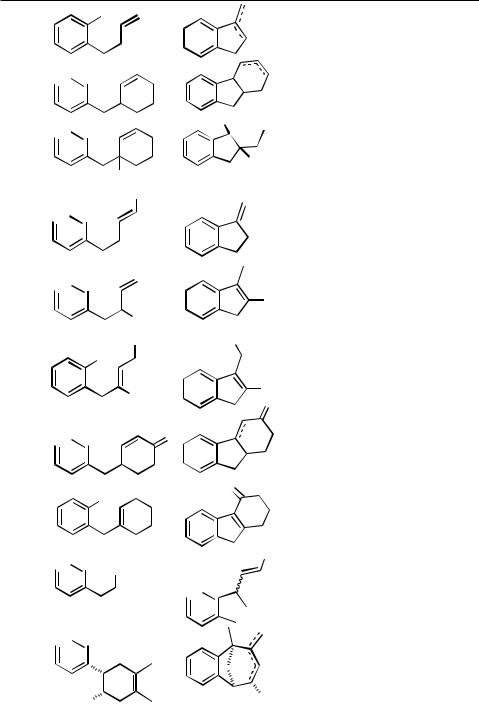
|
|
IV.2.2.1 |
SYNTHESIS OF CARBOCYCLES |
1229 |
|
TABLE 4. Synthesis of Indanes: Cyclization of 1-Halo-2-butenylarenes and Related |
|
||||
Compounds |
|
|
|
|
|
|
|
|
|
|
|
|
|
|
Catalyst, Solvent, |
Yield |
Ref- |
Entry |
Starting Material |
Product |
Temperature |
(%) |
erence |
1
2
3
4
5
6
7
8
9
10
I |
Pd(PPh3)2Cl2, |
89 |
|
||
|
Et3N, MeCN/PhH |
(60:40)a |
|
||
|
(1:1), 100 °C, 12 h |
|
|
|

 I
I

 I
I

 I
I
E = CO2Me

 I
I
E = CO2Me
I
E = CO2Me

 I
I
Br

 Br
Br

 I
I
E
E = CO2Me
H 

CN
CN
E
 E
E
|
|
|
|
E |
E |
|
|
||
E |
|
E |
||
E |
|
E |
||
|
||||
|
O |
|||
|
|
|
|
|
|
|
|
O |
|
O |
|
O |
||
|
||||
|
||||
|
|
|
|
|
|
|
|
|
|
Bu
OH

 Bu
Bu
 OH
OH
E
Pd(PPh3)4,
MeCN/THF, 60 °C, 24 h
Pd(OAc)2, PPh3,
Ag2CO3, MeCN, 80 °C, 72 h
Pd(OAc)2, n-Bu4NCl,
KOAc, DMF, 25 °C, 25 h
Pd(PPh3)4,
MeCN/PhH, 60 °C, 24 h
Pd(PPh3)4, Et3N, MeCN, 100 °C, 16 h
Pd(PPh3)4, Et3N, MeCN, 100 °C, 16 h
Pd(PPh3)4,
MeCN/THF, 100 °C,16 h
Pd(OAc)2(PPh3)2 DMF, 80 °C, 36 h
Pd(OAc)2, PPh3 MeCN, 80 °C,
24 h
Pd(OAc)2, TlOAc
or AgOAc, anisole, 120–148 °C
80
62
77 (5.25:1)a
71
50
65
50 (30)b
68
86
80c
[21]
[27]
[27]
[27]
[26]
[26]
[26]
[25]
[26]
[24]
[29]
(Continued)
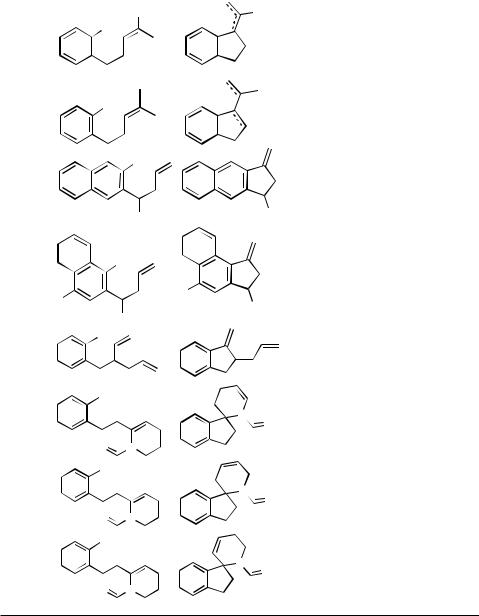
1230 |
IV Pd-CATALYZED REACTIONS INVOLVING CARBOPALLADATION |
|
|
|
|||||||||
TABLE 4. (Continued) |
|
|
|
|
|
|
|
|
|||||
|
|
|
|
|
|
|
|
|
|
|
|
|
|
|
Entry |
Starting Material |
|
Product |
Catalyst, Solvent, |
Yield |
Ref- |
||||||
|
|
|
|
|
|
|
|
|
|
Temperature |
(%) |
erence |
|
|
|
|
|
|
|
|
|
|
|
|
|
|
|
|
|
|
|
|
|
E |
|
|
E |
|
|
|
|
|
|
|
|
|
OTf |
|
|
|
Pd(PPh3)4, LiCl, |
80a |
|
|
|
11 |
|
|
|
|
|
|
|
|
[28] |
|
|||
|
|
|
|
|
|
|
|
|
|||||
|
|
|
|
|
|
|
|
Et3N, THF, |
(1.5:1) |
|
|||
|
|
|
|
|
|
E = CO2Et |
|
|
|
90 °C, 3 h |
|
|
|
|
|
|
|
|
|
|
|
|
|
|
|
|
|
|
|
|
|
|
OTf |
|
|
|
Pd(PPh3)4, LiCl, |
72a |
|
|
|
|
|
|
|
|
|
|
|
|
|
|
|
||
12 |
|
|
|
|
|
|
|
|
Et3N, THF, |
(6:1) |
[28] |
|
|
|
|
|
|
|
|
Br |
|
|
|
90 °C, 3 h |
|
|
|
|
|
|
|
|
|
|
|
|
Pd(OAc)2, |
|
|
|
|
13 |
|
|
|
|
|
|
|
|
Ag2CO3, dppp, |
96 |
[71],[72] |
||
|
|
|
|
|
|
|
|
|
|
MeCN, 80 °C, |
|
|
|
|
|
|
|
|
|
|
|
|
|
2 h |
|
|
|
|
|
|
|
|
|
OBn |
|
|
OBn |
|
|
|
|
|
|
|
|
|
|
|
|
|
|
|
|
|
|
|
|
|
|
|
|
|
|
|
|
Pd(OAc)2, |
|
|
|
|
|
|
|
|
|
|
|
|
|
|
|
|
|
|
|
|
|
|
|
|
|
|
|
|
|
|
|
|
|
|
|
|
|
|
|
|
|
|
|
|
|
14 |
|
|
|
|
Br |
|
|
|
Ag2CO3, dppp, |
96 |
[71],[72] |
||
|
|
|
|
|
|
|
|
MeCN, 80 °C, |
|||||
|
|
BnO |
|
BnO |
2 h |
|
|
|
|||||
|
|
|
|
|
|
|
|||||||
|
|
|
|
|
OMe |
|
|
|
|
||||
|
|
|
|
|
|
|
|
|
|
|
|
|
|
|
|
|
|
|
|
OMe |
|
|
|
|
|
|
|
|
|
|
|
|
I |
|
|
|
|
Pd(OAc)2, PPh3, |
|
|
|
|
|
|
|
|
|
|
|
|
|
|
|
|
|
15 |
|
|
|
|
|
|
|
|
Ag2CO3, MeCN, |
67 |
[73] |
|
|
|
|
|
|
|
|
|
|
|
|||||
|
|
|
I |
|
|
|
|
reflux, 24 h |
|
||||
|
|
|
|
|
|
|
|
|
|
|
|
||
|
|
|
|
|
|
|
|
|
|
|
|
|
|
16 |
|
|
|
|
|
|
|
N |
Pd(OAc)2, K2CO3, |
|
[74] |
|
|
|
|
|
|
|
|
|
|
|
|||||
|
|
|
|
|
|
|
Nt-Bu |
MeCN, 100 °C, |
54 |
|
|||
|
|
|
|
|
|
|
|
||||||
|
|
|
|
|
|
|
|
||||||
|
|
|
|
t-BuN |
N |
|
|
|
168 h |
|
|
|
|
|
|
|
|
|
|
|
|
|
|
||||
|
|
|
|
|
|
|
|
|
|
|
|||
|
|
|
|
|
I |
|
|
|
|
Pd(OAc)2, (+)- |
|
|
|
17 |
|
|
|
|
|
|
|
|
BINAP, Et3N, |
54 |
[74] |
|
|
|
|
|
|
|
|
|
|
|
|||||
|
|
|
|
|
|
|
N |
cyclohexene, |
|
||||
|
|
|
|
|
|
|
|
||||||
|
|
|
|
|
|
|
|
|
Nt-Bu |
MeCN, 60 °C, |
|
|
|
|
|
|
|
|
|
|
|
|
|
|
|
||
|
|
|
|
t-BuN |
N |
|
|
|
3 h |
|
|
|
|
|
|
|
|
|
|
|
|
|
|
||||
|
|
|
|
|
I |
|
|
|
|
Pd(OAc)2, TlOAc, |
|
|
|
18 |
|
|
|
|
|
|
|
|
|
[74] |
|
||
|
|
|
|
|
|
|
|
|
|
||||
|
|
|
|
|
|
|
N |
Et3N, MeCN, |
79 |
|
|||
|
|
|
|
|
|
|
|
||||||
|
|
|
|
t-BuN |
N |
|
|
Nt-Bu |
80 °C, 17 h |
|
|
|
|
|
|
|
|
|
|
|
|
|
|||||
|
|
|
|
|
|
|
|
|
|
|
|||
aMixture of double bond isomers (ratio in parentheses).
bYield of the corresponding cyclohexane derivative, formed by 6-endo process.
cMixture of double bond positional isomers.
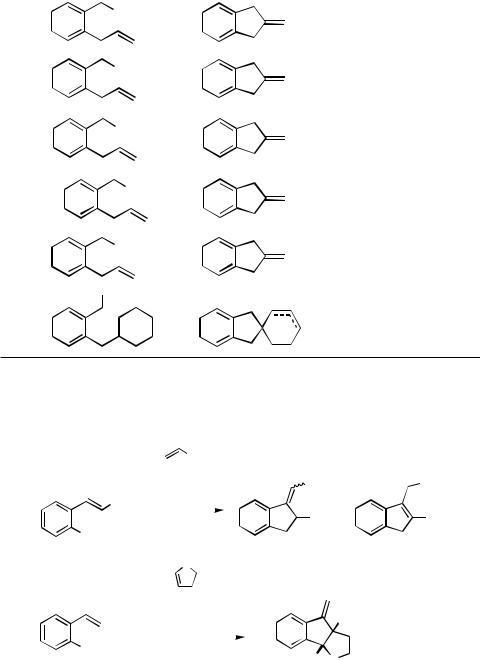
|
|
|
|
|
|
|
IV.2.2.1 |
SYNTHESIS OF CARBOCYCLES |
1231 |
TABLE 5. Synthesis of Indanes: Cyclization of 1-Halomethyl-2-propenylarenes and Related |
|||||||||
Compound[16] |
|
|
|
|
|
||||
|
|
|
|
|
|
|
|
|
|
Entry |
Starting Material |
Product |
Catalyst, Solvent, |
Yield |
|||||
|
|
|
|
|
|
|
|
Temperature |
(%) |
|
|
|
|
|
|
|
|
|
|
1 |
|
|
OSO2Me |
|
|
|
Pd(PPh3)2, Et3N, |
60 a |
|
|
|
|
|
||||||
|
|
|
OCO2Me |
|
|
|
MeCN, reflux, 1 h |
|
|
|
|
|
|
|
|
|
|||
2 |
|
|
|
|
|
Pd(PPh3)2, Et3N, |
26 |
||
|
|
|
|
||||||
|
|
|
|
|
|
|
|||
|
|
|
I |
|
|
|
MeCN, reflux, 5 d |
(23)b |
|
|
|
|
|
|
|
||||
3 |
|
|
|
|
|
Pd(PPh3)2, Et3N, |
64 |
||
|
|
|
|
||||||
|
|
|
|
|
|
|
(18)b |
||
|
|
|
|
Br |
|
|
|
MeCN, reflux, 0.5 h |
|
4 |
|
|
|
|
|
|
Pd(PPh3)2, Et3N, |
82a |
|
|
|
|
|
|
|||||
|
|
|
|
|
|
|
|||
|
|
|
Cl |
|
|
|
MeCN, reflux, 0.5 h |
82a |
|
|
|
|
|
|
|
||||
5 |
|
|
|
|
|
Pd(PPh3)2, Et3N, |
|||
|
|
|
|
|
|||||
|
|
|
|
|
|
|
|||
|
|
|
Cl |
|
|
|
MeCN, reflux, 1 h |
|
|
|
|
|
|
|
|
|
|
||
6 |
|
|
|
|
|
|
|
Pd(PPh3)2, Et3N, |
60 |
|
|
|
|
|
|
|
|||
|
|
|
|
|
|
|
|
MeCN, reflux, 24 h |
(70:30)c |
|
|
|
|
|
|
|
|
||
aThe isomeric 2-methylindene was produced in 1% yield.
bYield of the isomeric compound, 2-methylindene, in parentheses.
cRatio of double bond positional isomers in parentheses.
|
|
R2 |
|
|
|
|
|
|
|
||
|
|
Pd(OAc)2, K2CO3 |
|
|
R1 |
|
|
|
R1 |
||
|
LiCl, Bu4NCl, DMF |
|
|
|
|
|
|||||
R1 |
|
60–100 °C |
|
|
|
|
|
|
|
|
|
|
|
X = Br, I |
|
|
R2 |
+ |
|
|
R2 |
||
|
|
|
|||||||||
X |
|
34–74% |
|
R1 = H, Me |
|
||||||
|
|
|
|
|
|
|
|||||
|
|
O |
|
R2 = H, Me, Ph, OEt |
|
||||||
|
Pd(OAc)2, K2CO3, LiCl |
|
|
|
|
|
|
|
|||
|
|
Bu4NCl, NMP |
|
|
|
H |
|
||||
Br |
|
80 °C, 48 h |
|
|
|
|
|
|
|
||
|
|
|
|
|
|
|
|
||||
41% |
|
|
|
|
H |
O |
|
||||
|
|
|
|
|
|
|
|
||||
Scheme 4
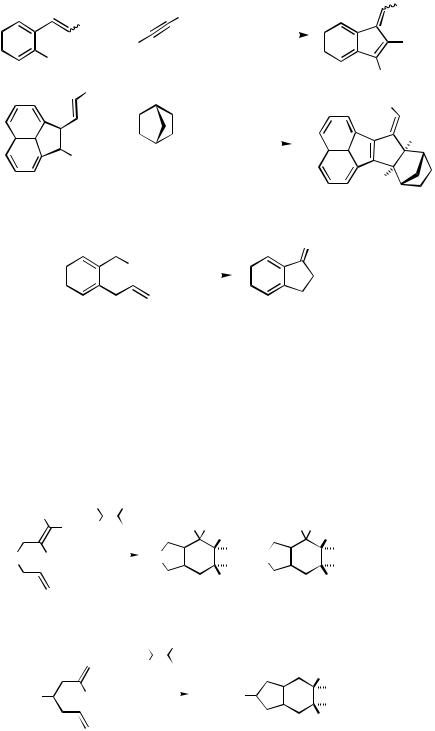
1232 |
|
IV Pd-CATALYZED REACTIONS INVOLVING CARBOPALLADATION |
|
|||||||||||||||||||
|
|
|
|
|
|
|
|
|
|
|
|
Pd(OAc)2, KOAc |
E |
|||||||||
|
|
|
|
|
|
|
|
|
Ph |
anisol |
|
|
|
|
|
|
||||||
|
|
|
|
|
|
|
|
|
|
|
|
|
|
|
|
|||||||
|
|
|
|
|
E |
120 |
°C, 18 h |
|
|
|
|
|
|
|
||||||||
|
+ |
|
Ph |
|
|
|
|
|
|
|
|
|
|
|
|
|
|
Ph |
||||
|
|
|
|
|
|
80% |
|
|
|
|
|
|
|
|||||||||
|
|
|
|
|
|
|
|
|
|
|
|
|
|
|
|
|
|
|
||||
|
|
|
|
|
|
|
|
|
|
|
|
|
||||||||||
|
|
|
I |
|
|
|
|
E = CO2Me |
|
|
|
|
|
|
|
|||||||
|
|
|
|
|
E |
|
|
|
|
|
|
|
|
|
|
Ph |
||||||
|
|
|
|
|
|
|
|
|
|
|
|
|
|
|
|
|
|
|
E |
|||
|
|
|
|
|
|
|
|
|
|
Pd(OAc)2, PPh3, |
|
|
|
|
|
|
||||||
|
|
|
|
|
|
|
|
|
|
|
|
|
|
|
|
|
||||||
|
+ |
|
|
|
TlOAc, MeCN |
|
|
|
|
|
|
|
||||||||||
|
|
|
|
|
|
|
|
|
|
|
|
reflux |
|
|
|
|
|
|
|
H |
||
|
|
|
|
|
|
|
|
|
|
|
|
|
|
|
|
|
|
|||||
|
|
|
|
|
Br |
62% |
|
|
|
|
|
|
|
|
||||||||
|
|
|
|
|
|
|
|
|
|
|
|
|
||||||||||
|
|
|
|
|
|
|
|
|
|
|
|
|
|
|
|
|
|
|
|
|||
|
|
|
|
|
|
|
|
|
|
|
E = CO2Me |
|
|
|
|
|
|
H |
||||
|
|
|
|
|
|
|
|
|
|
|
|
|
|
|
|
|
|
|||||
|
|
|
|
|
|
|
|
|
Scheme 5 |
|
|
|
|
|
|
|
|
|
|
|||
|
|
|
|
|
O |
Pd(PPh3)4, NEt3, |
|
|
|
O |
|
|||||||||||
|
|
|
|
|
|
|
|
|
MeCN/PhH |
|
|
|
|
|
|
|
|
|
|
|||
|
|
|
|
|
|
|
Cl |
|
55 °C, 1 h |
|
|
|
|
|
|
|
|
|
|
|
||
|
|
|
|
|
|
|
|
|
|
|
|
|
|
|
|
|||||||
|
|
|
|
|
|
|
|
50% |
|
|
|
|
|
|
|
|
|
|
|
|
|
|
|
|
|
|
|
|
|
|
|
|
|
|
|
|
|
|
|
|
|
|
|
||
|
|
|
|
|
|
|
|
|
|
|
|
|
|
|
|
|
|
|
|
|
||
Scheme 6
during the cyclization or added afterwards in a one-pot process) to give bicyclo[4.3.0]nonene derivatives and heterocyclic analogs in good to excellent yields (Schemes 7 and 8, Tables 6 and 7). While methyl 2-chloro-2-cyclopropylideneacetate and methyl 2-cyclopropylideneacetate as the dienophiles gave the corresponding fivemembered ring annelated spiro[2.5]octene derivatives in very good yields in both the onestep and the two-step procedure (Table 6, entries 13 and 14), the highly strained methyl dimethylcyclopropenecarboxylate and 1,2-dicyanocyclobut-1-ene gave the expected tricyclic products in only moderate yields (Table 6, entries 16 and 17). The yield of the latter reaction could be increased by performing the second step under high pressure
|
R6 |
R1 |
R4 |
|
|
|
|
|
|
|
|||||
|
|
|
|
|
|
|
|
|
|
R5 R6 R4 |
|
|
|
R5 R6 R1 |
|
|
|
|
|
|
|
|
|
|
|
|
|
|
|||
|
R5 |
R2 |
R3 |
|
|
|
|
|
|||||||
|
|
|
|
“Pd” |
|
|
R3 |
|
|
|
R2 |
||||
|
|
|
|
|
|
||||||||||
X |
Br |
|
|
|
|
|
|
X |
|
|
R2 + X |
|
|
|
R3 |
|
|
|
|
|
|
|
|||||||||
|
|
|
|
|
|
|
|
|
|
|
R1 |
|
|
|
R4 |
|
|
|
|
|
|
|
|
|
isomer I |
isomer II |
|||||
|
|
|
|
|
|
|
|
|
|
|
Scheme 7 |
|
|
|
|
|
|
|
|
|
|
R1 |
|
R4 |
|
|
|
|
|||
|
|
|
|
|
|
|
|
|
|
|
|
|
|
||
|
|
|
|
|
|
|
|
|
|
|
|
|
|
||
|
|
|
|
|
|
R2 |
|
R3 |
|
|
|
R1 |
|||
|
|
|
|
|
|
|
|
“Pd” |
|
|
|
R2 |
|||
|
R5O |
Br |
|
|
|
|
|
|
R5O |
|
|
|
R3 |
||
|
|
|
|
|
|
|
|
|
|
||||||
|
|
|
|
|
|
|
|
|
|
|
|
|
|
|
|
|
|
|
|
|
|
|
|
|
|
|
|
|
|
|
R4 |
|
|
|
|
|
|
|
|
|
|
|
Scheme 8 |
|
|
|
|
